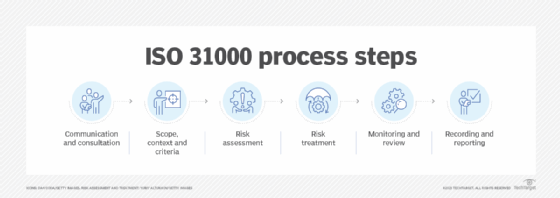ISO 31000 Risk Management
What is ISO 31000 Risk Management?
The ISO 31000 Risk Management framework is an international standard that provides organizations with guidelines and principles for risk management. The standard was developed by the International Organization for Standardization (ISO).
Regulatory compliance initiatives are usually specific to a particular country and apply to certain sized businesses or businesses in specific industries. However, ISO 31000 is designed to be used in organizations of any size. Its concepts work equally well in the public and the private sector, or in large and small businesses and nonprofit organizations.
ISO 31000 provides a universal standard for practitioners and companies employing risk management processes. With this, organizations can increase the odds of identifying risks and properly plan to allocate resources to mitigate them.
As a process, the goal of risk management is to identify, assess and control threats to an organization's capital, earnings and operations. A successful risk management framework helps an organization consider the full range of risks it faces while also examining the relationship between different risks and the effect they could have.
These risks could stem from a variety of sources, such as financial uncertainties, legal liabilities, technology issues, strategic management errors, accidents and natural disasters.
ISO 31000 provides a set of principles and guidelines for the design and implementation of a risk management framework. The standard enables organizations to apply risk management to all strategic, management and operational tasks as well as to projects, functions and processes.
ISO 31000:2018 is the most recent version of the standard. Other risk management standards also exist, including the ISO IEC 31010 standard for risk management by the ISO and the International Electrotechnical Commission.
ISO 31000 framework and guidelines
The risk management framework is made up of the following six distinct areas:
- Leadership. Leaders within the organization must take the initiative to ensure that ISO 31000 is adopted and applied in a way that aligns with the organization's culture and business objectives.
- Integration. While it's important to integrate risk mitigation into as many organizational processes as possible, it's important not to cause operational bottlenecks or stand in the way of core business processes being performed.
- Design. Organizations need to design a risk management strategy based on their needs.
- Implementation. The implementation process integrates the organization's risk management design into business processes. Implementation is usually a formal process with stated objectives, deadlines and reporting requirements.
- Evaluation. Evaluation assesses the design to determine what is working and what might need to be refined.
- Improvement. Organizations should continuously look for ways to improve their ISO 31000 implementation.
The ISO 31000 framework may be structured differently depending on the organization and its decision on how to implement the standard. For example, an organization can follow ISO 31000 using the following six guidelines:
- Scope.
- Normative references.
- Terms and definitions.
- Principles.
- Framework.
- Process.
ISO 31000's risk management principles
ISO 31000 seeks to help organizations take a methodical approach to risk management by doing the following three key things:
- Identifying risks.
- Evaluating the probability of an event tied to an identified risk occurring.
- Determining the severity of the problems caused by the event occurring.
As such, ISO 31000 doesn't seek to eliminate risks, as the total removal of all risks is impossible. Instead, it's meant to help organizations identify their risks and establish a strategy for mitigating or reducing risks where appropriate.
The following eight core ISO 31000 principles are the foundation for establishing a risk management framework:
1. Inclusive. For efforts to be successful, key stakeholders must be involved and their knowledge and views considered. Risk management should also be transparent, easy to understand and not include confusing jargon.
2. Dynamic. Organizations change over time. As such, the risk sources that are relevant to an organization today might change tomorrow. Organizations must perform ongoing risk analysis if their risk mitigation efforts are to continue to work.
3. Best available information. Risk mitigation efforts must be based on the best and most current information available to stakeholders. However, organizations must also acknowledge that they will never have all of the information needed and that unanticipated risks will always exist.
4. Human and cultural factors. Human behavior and culture influence risk management. The list of identified risks should include those related to human error or to the organization's unique culture.
5. Continual improvement. Long-term adherence to ISO 31000 means adopting the principles of continuous improvement to ensure that the organization's risk mitigation efforts improve over time.
6. Integrated. The concepts of risk mitigation and identification should be integrated into all business processes.
7. Structured and comprehensive. Organizations should create a comprehensive risk mitigation strategy that addresses all known risks.
8. Customized. Because every organization is unique, the concepts of ISO 31000 should be custom-tailored to the organization to reach its objectives.
Benefits and challenges of ISO 31000 standard
There are several benefits associated with adopting the ISO 31000 standard, including the following:
- Effectiveness. Because ISO 31000 is an internationally recognized standard, it's used by countless organizations. This means that ISO 31000 has been thoroughly vetted and proved to be effective.
- Addresses risks in a standardized way. When properly implemented, ISO 31000 acts as a template to help organizations identify key drivers of risk. It establishes risk criteria and risk treatments in a standardized way.
- Creates a culture of risk mitigation. By incorporating risk mitigation into nearly all business processes, employees become used to the idea of identifying and potentially mitigating risks.
- Increases the organization's profitability. When an organization mitigates unnecessary risks, it also reduces the potential for financial damage stemming from events tied to that risk.
- Utilizes what is already in place. ISO 31000 is just one of many ISO standards. The various standards are designed to work together, which means that organizations should be able to incorporate the ISO 31000 strategy within their existing management systems without much additional work.
- Compels an organization to be more preemptive. A good ISO 31000 implementation can help an organization shift from being reactive to taking a more proactive approach to risk mitigation.
- Helps the organization acquire funding more easily. Banks and investors tend to be risk-adverse. If an investor is convinced that an organization is serious about identifying and mitigating risks, it might be more likely to approve an investment.
Although there are clear advantages to adopting ISO 31000, there are also some challenges that must be considered, including the following:
- Adherence requires a continuous effort. If an organization fails to incorporate ISO 31000 concepts into its business processes, the risk mitigation plan that it creates will quickly become outdated and likely be ignored by employees.
- Potential for a false sense of security. Even with an effective risk mitigation plan in place, organizations must remember that there will always be unidentified risks.
- Organizations can become risk averse. Risk aversion can make it difficult for an organization to capitalize on new opportunities.

How to effectively implement ISO 31000
Each organization will need to take a unique approach to ISO 31000, as every organization is different. Even so, ISO outlines the following three key steps for getting started:
- Be aware of objectives. An organization's risk mitigation strategy should align with its business objectives, not get in the way of them.
- Assess existing governance. Larger organizations likely already have a governance structure in place. That existing structure can be useful in the formulation of roles and procedures related to ISO 31000.
- Consider the level of commitment. Prior to implementing ISO 31000, organizations should consider the resources they are willing to invest in their risk mitigation efforts.
The following process steps in the ISO 31000 guidelines can be done in sequence, and should also be repeated consistently:
- Communication and consultation. This step aims to increase awareness and understanding among stakeholders while also gathering input and information to aid decision-making. It should take place throughout all steps of the implementation process.
- Scope, context and criteria. The goal of these three steps is to customize ISO 31000 to the company's risk management needs. Organizations should be aware of the breadth of implementing risk management. They should also understand the internal and external environment of the company. Finally, the organization should establish criteria based on company priorities, objectives and policies. The criteria should be reevaluated throughout the implementation process and amended if necessary.
- Risk assessment. This step is made up of the following three separate processes:
- Risk identification. The goal is to find and define risks that could harm or hinder a company's business objectives.
- Risk analysis. The goal is to evaluate and comprehend any risks and their features, including the risk level, complexity, sources, probability, circumstances and effective controls.
- Risk evaluation. The goal is to compare the risk analysis to the risk criteria to determine where action is needed to support those decisions.
- Risk treatment. The purpose of this step is to choose and apply risk management options.
- Monitoring and review. This step should take place during all stages of the implementation process. The goal is to assess the effectiveness of the process implementation and find any room for improvement.
- Recording and reporting. This step aims to document the implementation process and communicate activities and outcomes to the organization.
Learn more about how to implement risk management frameworks like ISO 31000, COSO or British Standard 31100.







